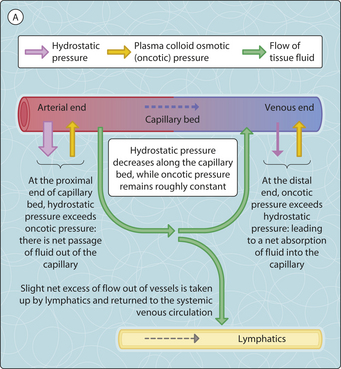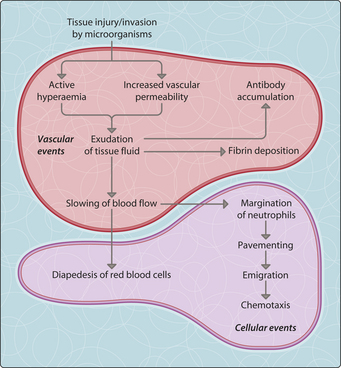Chapter 5 Acute inflammation: mechanisms
Acute inflammation is the initial reaction of vascularized tissue to an injury. Causes include physical or chemical aetiologies (e.g. trauma, heat cold, radiation, toxins, corrosives), microorganisms or their toxins, infarction and hypersensitivity reactions. The events in acute inflammation are complex and only partially understood. For ease of description, they can be divided into vascular and cellular components (Fig. 3.5.1).
Vascular events
The initial events are active hyperaemia (an increase in blood flow owing to relaxation of precapillary sphincters) and an increase in permeability of the capillaries to plasma proteins, allowing these to leak into the extravascular space. In normal tissues, fluid is forced out at the arterial end of the capillary bed by hydrostatic pressure, but most is reabsorbed at the venous end where the hydrostatic pressure is lower because then the colloid osmotic (or oncotic) pressure gradient exceeds the hydrostatic pressure gradient. Any excess tissue fluid is taken up by the lymphatics. In inflammation, the colloid osmotic pressure of the blood is reduced because plasma proteins have exuded into the interstitial matrix (Fig. 3.5.2). It appears that plasma proteins can escape by one of two mechanisms:
 as part of the acute inflammatory response, transient gaps appear in the endothelium of venules and small veins because the endothelial cells (which have contractile proteins such as actin in their cytoplasm) contract
as part of the acute inflammatory response, transient gaps appear in the endothelium of venules and small veins because the endothelial cells (which have contractile proteins such as actin in their cytoplasm) contract

Fig. 3.5.2 Fluid movement in and out of tissues. (A) Normal movement; (B) movement in inflamed tissue.
Stay updated, free articles. Join our Telegram channel

Full access? Get Clinical Tree










